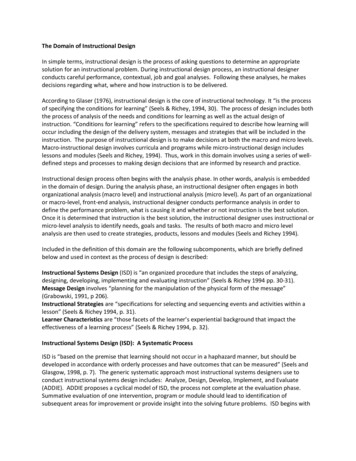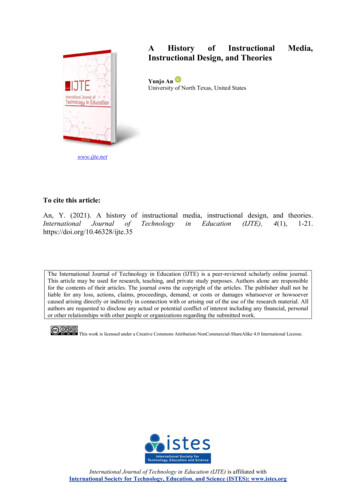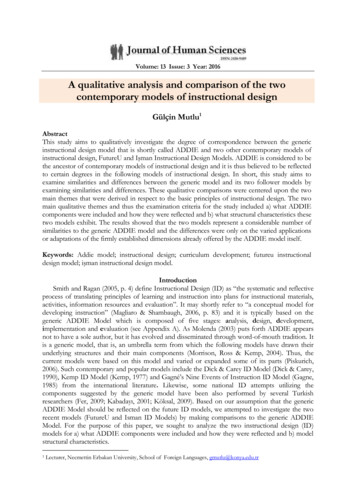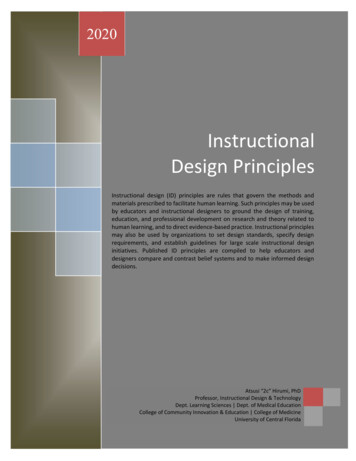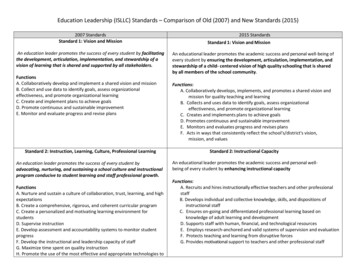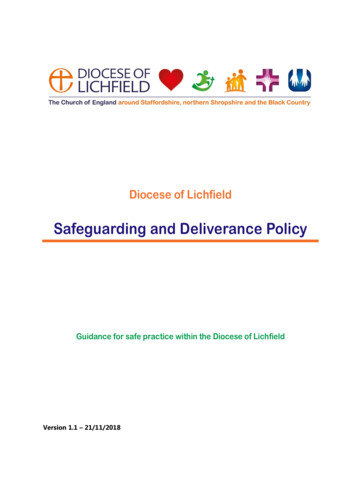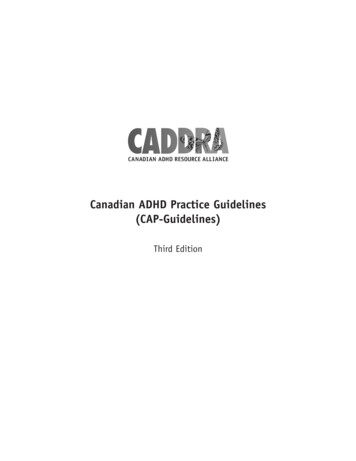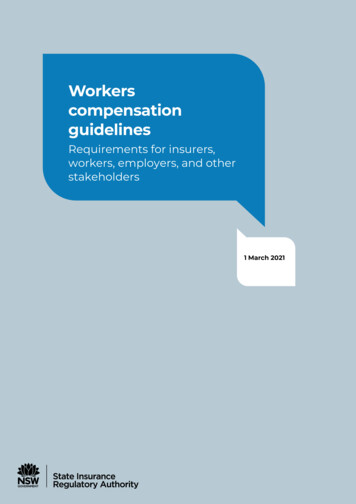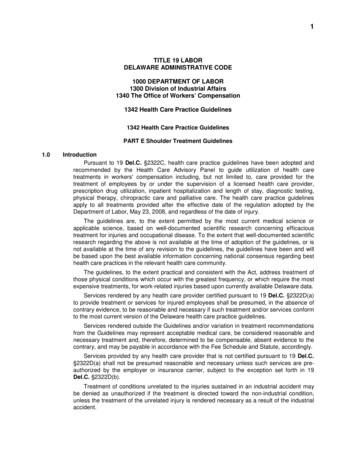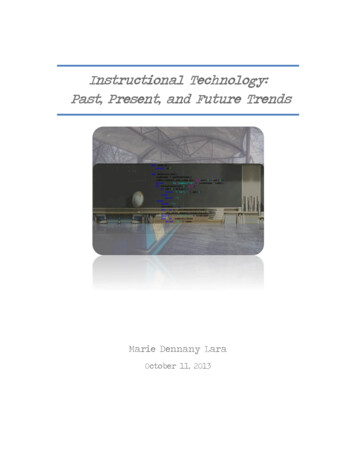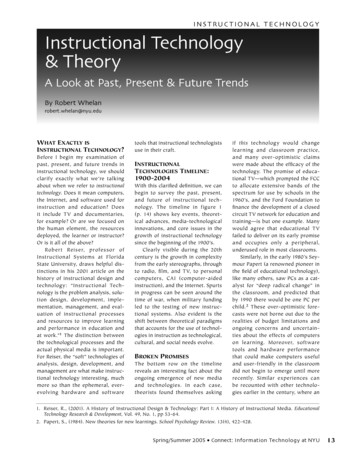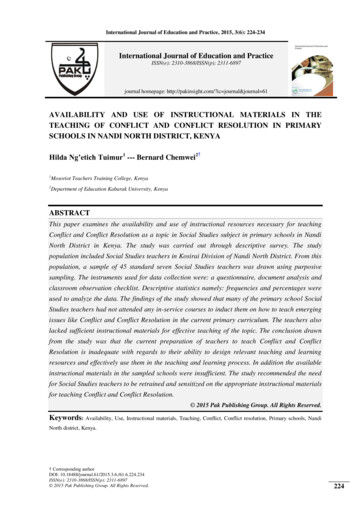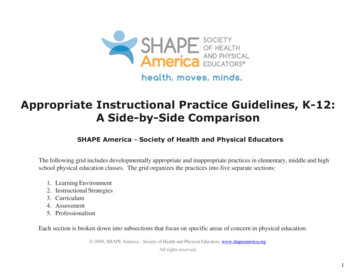
Transcription
Appropriate Instructional Practice Guidelines, K-12:A Side-by-Side ComparisonSHAPE America – Society of Health and Physical EducatorsThe following grid includes developmentally appropriate and inappropriate practices in elementary, middle and highschool physical education classes. The grid organizes the practices into five separate sections:1.2.3.4.5.Learning EnvironmentInstructional StrategiesCurriculumAssessmentProfessionalismEach section is broken down into subsections that focus on specific areas of concern in physical education. 2009, SHAPE America – Society of Health and Physical Educators, www.shapeamerica.org.All rights reserved.1
The Learning Environment section includes: Establishing the Learning Environment Exercise as Punishment Safety Diversity Equity Inclusion Competition & CooperationThe Instructional Strategies section includes: Expectations for Student Learning Class Organization Class Design Learning Time Maximum Participation Teaching/Learning Styles Teacher Enthusiasm Success Rate Teacher Feedback Technology UseThe Assessment section includes: Assessment Use Variety of Assessments Fitness Testing Testing Procedures Reporting Student Progress Grading Program AssessmentThe Curriculum section includes: Productive Motor Skill Learning Experiences Concept Knowledge Regular Participation Developing Health-Related Fitness Self-Responsibility & Social Skills Valuing Physical Activity Interdisciplinary Instruction Special EventsThe Professionalism section includes: Professional Growth Professional Learning Community AdvocacyThe practices mentioned are not meant to be an exhaustive list. These are basic instructional practices. Many other practicesthat would be included in an excellent program are not enumerated here. But the list does include the practices observed recentlyin gymnasiums, pools and fields across the United States. 2009, SHAPE America – Society of Health and Physical Educators, www.shapeamerica.org.All rights reserved.2
e:ElementaryAppropriatePractice:Middle SchoolInappropriatePractice:Middle SchoolAppropriatePractice:High SchoolInappropriatePractice:High ing theLearning Environment1.1Establishing theLearning Environment1.1Establishing theLearning Environment1.1Establishing theLearning Environment1.1Establishing theLearning Environment1.1Establishing theLearning Environment1.1.1 The teachersystematically plans for,develops and maintains apositive learning environment that is focused onmaximizing learning andparticipation, in an atmosphere of respect and support from the teacher andthe child’s peers.1.1.1 The environmentis not supportive or safe(e.g., the teacher makesdegrading or sarcastic remarks). As a result, somechildren feel embarrassed,humiliated and generallyuncomfortable in physicaleducation class.1.1.1 The teachersystematically plans for,develops and maintains apositive learning environment that allows studentsto feel safe (physicallyand emotionally), supported and unafraid tomake mistakes.1.1.1 The teacher doesn’testablish a positive, supportive and safe learning environment. As aresult, some students feelembarrassed, humiliatedand generally uncomfortable in physical educationclass.1.1.1 The teachersystematically plans for,develops and maintains apositive learning environment that allows studentsto feel safe (physicallyand emotionally), supported and unafraid tomake mistakes.1.1.1 The teacher fails toestablish a positive, supportive and safe learning environment. As aresult, some students feelembarrassed, humiliatedand generally uncomfortable in physical educationclass.1.1.2 The environment issupportive of all childrenand promotes developinga positive self-concept.Children are allowedto try, to fail, and to tryagain, free of criticismor harassment from theteacher or other students.1.1.2 Only highly skilledor physically fit childrenare viewed as successful learners. Teachersand peers overlook and/or ignore students whoare not highly skilled orphysically fit.1.1.2 The environment issupportive of all studentsand promotes developinga positive self-concept.Students are allowed totry, to fail, and to tryagain, free of criticismor harassment from theteacher or other students.1.1.2 Only highly skilledor physically fit studentsare viewed as successful learners. Teachersand peers overlook and/or ignore students whoare not highly skilled orphysically fit.1.1.2 The environment issupportive of all studentsand promotes developinga positive self-concept.Students are allowed totry, to fail, and to tryagain, free of criticismor harassment from theteacher or other students.1.1.2 Only highly skilledor physically fit studentsare viewed as successful learners. Teachersand peers overlook and/or ignore students whoare not highly skilled orphysically fit.1.1.3 Programs are designed to guide childrento take responsibility fortheir own behavior andlearning. Emphasis ison intrinsic, rather thanextrinsic, incentives.1.1.3 Children behaveappropriately becausethey fear receiving a poorgrade or other “punishment” if they don’t followthe teacher’s rules.1.1.3 Programs are designed to guide studentsto take responsibility fortheir own behavior andlearning. Emphasis ison intrinsic, rather thanextrinsic, incentives.1.1.3 Students behaveappropriately becausethey fear receiving a poorgrade or other “punishment” if they don’t followthe teacher’s rules.1.1.3 Programs are designed to guide studentsto take responsibility fortheir own behavior andlearning. Emphasis ison intrinsic, rather thanextrinsic, incentives.1.1.3 Students behaveappropriately becausethey fear receiving a poorgrade or other “punishment” if they don’t followthe teacher’s rules.3
e:ElementaryAppropriatePractice:Middle SchoolInappropriatePractice:Middle SchoolAppropriatePractice:High SchoolInappropriatePractice:High School1.1.4 Fair and consistentclassroom-managementpractices encouragestudent responsibilityfor positive behavior.Students are included inthe process of developingclass rules/agreements.1.1.4 The rules are unclear and can vary fromday to day.1.1.4 Fair and consistentclassroom-managementpractices encouragestudent responsibilityfor positive behavior.Students are included inthe process of developingclass rules/agreements.1.1.4 The rules are unclear and can vary fromday to day.1.1.4 Fair and consistentclassroom-managementpractices encouragestudent responsibilityfor positive behavior.Students are included inthe process of developingclass rules/agreements.1.1.4 The rules are unclear and can vary fromday to day.1.1.5 Bullying, tauntingand inappropriate studentremarks and behaviors aredealt with immediatelyand firmly.1.1.5 Verbal or nonverbalbehavior that is hurtful toother children is overlooked and/or ignored.1.1.5 Bullying and inappropriate student remarksand behaviors are dealtwith immediately andfirmly.1.1.5 Verbal or nonverbalbehavior that is hurtful toother students is overlooked and ignored.1.1.5 Bullying, tauntingand inappropriate studentremarks and behaviors aredealt with immediatelyand firmly.1.1.5 Verbal or nonverbalbehavior that is hurtful toother students is overlooked and/or ignored.1.2Exerciseas Punishment1.2Exerciseas Punishment1.2Exerciseas Punishment1.2Exerciseas Punishment1.2Exerciseas Punishment1.2Exerciseas Punishment1.2.1 Teachers promoteexercise for its contribution to a healthy lifestyle.Children are encouragedto participate in physical activity and exerciseoutside of the physicaleducation setting forenjoyment, skill development and health reasons.41.2.1 Teachers useactivities/exercises (e.g.,running laps, performing pushups) to punishmisbehavior.1.2.1 Teachers promoteexercise for its contribution to a healthy lifestyle.Students are encouragedto participate in physical activity and exerciseoutside of the physicaleducation setting forenjoyment, skill development and health reasons.1.2.1 Teachers useactivities/exercises (e.g.,running laps, performing pushups) to punishmisbehavior.1.2.1 Teachers promoteexercise for its contribution to a healthy lifestyle,encouraging students toparticipate in physical activity and exercise outsideof the physical educationsetting for enjoyment,skill development andhealth reasons.1.2.1 Teachers useactivities/exercises (e.g.,running laps, performing pushups) to punishmisbehavior.
e:ElementaryAppropriatePractice:Middle SchoolInappropriatePractice:Middle SchoolAppropriatePractice:High SchoolInappropriatePractice: afety1.3Safety1.3.1 Teachers makeevery effort possible tocreate a safe learningenvironment for students(e.g., actively teachingsafety, posting and practicing emergency actionplans).1.3.1 Teachers allow orignore unsafe practices(e.g., pushing, shovingor tackling children inball games) that occur intheir classes. Childrenare permitted to ignorethe safety of others in theclass or use equipmentunsafely (e.g., swingingbats in close proximity toothers).1.3.2 Activities are selected carefully to ensurethat they match students’ability levels and are safefor all students, regardlessof ability level.1.3.3 Teachers maintainup-to-date first aid, AEDand CPR certifications.1.3.4. Facilities andequipment are maintainedand inspected regularlyfor safety hazards (e.g.,glass, improper groundcover under equipment).1.3.2 Human-targetgames (dodge ball) and/or drills that allow aggressive behavior towardother students are permitted.1.3.3 Teachers don’tmaintain up-to-date firstaid, AED and CPR certifications.1.3.4 No regular facilitysafety inspection occurs.Dangerous or outdatedequipment is used.1.3.1 Teachers makeevery effort possible tocreate a safe learningenvironment for students(e.g., emergency actionplans are posted andpracticed).1.3.1 Teachers allow orignore unsafe practices(e.g., pushing, shovingor tackling students inball games) that occur intheir classes. Studentsare permitted to ignorethe safety of others in theclass or use equipmentunsafely (e.g., swingingbats or golf clubs in closeproximity to others).1.3.1 Activities areselected carefully andmodified to ensure a safelearning environment forstudents. Emergency action plans are posted andpracticed.1.3.1 Teachers allow orignore unsafe practices(e.g., pushing, shovingor tackling students inball games) that occur intheir classes. Studentsare permitted to ignorethe safety of others in theclass or use equipmentunsafely (e.g., swingingbats or golf clubs in closeproximity to others).1.3.2 Activities are selected carefully to ensurethat they match students’ability levels and are safefor all students, regardlessof ability level.1.3.2 Human-targetgames (dodge ball) and/or drills that allow aggressive behavior towardother students are permitted.1.3.2 Activities are selected carefully to ensurethat they match students’ability levels and are safefor all students, regardlessof ability level.1.3.2 Human-targetgames (dodge ball) and/or drills that allow aggressive behavior towardother students are permitted.1.3.3 Physical educators maintain up-to-datefirst aid, AED and CPRcertifications.1.3.3 Physical educatorsdon’t maintain up-to-datefirst aid, AED and CPRcertifications.1.3.3 Physical educators maintain up-to-datefirst aid, CPR and AEDcertifications.1.3.3 Physical educatorsdon’t maintain up-to-datefirst aid, CPR and AEDcertifications.1.3.4 Facilities andequipment are maintainedand inspected regularlyfor safety hazards.1.3.4 No regular facilitysafety inspection occurs.Dangerous or outdatedequipment is used.1.3.4. Facilities andequipment are maintainedand inspected regularlyfor safety hazards.1.3.4. No regular facilitysafety inspection occurs.Dangerous or outdatedequipment is used.5
e:ElementaryAppropriatePractice:Middle SchoolInappropriatePractice:Middle SchoolAppropriatePractice:High SchoolInappropriatePractice:High School1.3.5 Physical educationclass size is consistentwith those of other subject areas.1.3.5 Teachers routinelycombine classes so thatone teacher supervisesa double class while theother completes someother activity.1.3.5 Physical educationclass size is consistentwith those of other subject areas.1.3.5 Teachers routinelycombine classes so thatone teacher supervisesa double class while theother completes someother activity.1.3.5 Physical educationclass size is consistentwith those of other subject areas.1.3.5 Teachers routinelycombine classes so thatone teacher supervisesa double class while theother completes someother activity.1.3.6 Teachers ensurestudent safety by monitoring class closely.1.3.6 Teachers routinelyposition themselves sothat they don’t have allchildren in view, or theyleave classes unsupervised for periods of time.1.3.6 Teachers ensurestudent safety by monitoring class closely.1.3.6 Teachers routinelyleave classes unsupervised to perform othertasks (e.g., cutting grass,watching game tapes,talking on the phone).1.3.6 Teachers ensurestudent safety by monitoring class closely.1.3.6 Teachers routinelyleave classes unsupervised to perform othertasks (e.g., cutting grass,watching game tapes,talking on the rsity1.4Diversity1.4.1 Teachers create anenvironment that isinclusive and supportiveof all children, regardless of race, ethnic origin,gender, sexual orientation,religion or physical ability. Such differences areacknowledged, appreciated and respected.1.4.1 The physical education environment supportshighly skilled childrenmore fully than childrenwith less skill development (e.g., posters on display are predominantly ofmale professional athletesfrom the “major” sports).1.4.1 Teachers create anenvironment that isinclusive and supportiveof all students, regardless of race, ethnic origin,gender, sexual orientation,religion or physical ability. Such differences areacknowledged, appreciated and respected.1.4.1 The physical education environment supportshighly skilled studentsmore fully than studentswith less skill development (e.g., posters on display are predominantly ofmale professional athletesfrom the “major” sports).1.4.1 Teachers create anenvironment that isinclusive and supportiveof all students, regardless of race, ethnic origin,gender, sexual orientation,religion or physical ability. Such differences areacknowledged, appreciated and respected.1.4.1 The physical education environment supportshighly skilled studentsmore fully than studentswith less skill development (e.g., posters on display are predominantly ofmale professional athletesfrom the “major” sports).1.4.2 Teachers intentionally select activities thatrepresent a culturallydiverse environment (e.g.,dances and games fromaround the world).1.4.2 Teachers teachAmerican team sports(e.g., football, basketball, softball) exclusively.1.4.2 Teachers intentionally select activities thatrepresent a culturallydiverse environment (e.g.,dances and games fromaround the world).1.4.2 Teachers teachAmerican team sports(e.g., football, basketball, softball) exclusively.1.4.2 Teachers intentionally select activities thatrepresent a culturallydiverse environment (e.g.,dances and games fromaround the world).1.4.2 Teachers teachAmerican team sports(e.g., football, basketball, softball) exclusively.61.4Diversity
e:ElementaryAppropriatePractice:Middle SchoolInappropriatePractice:Middle SchoolAppropriatePractice:High SchoolInappropriatePractice:High y1.5Equity1.5.1 All children (boysand girls, high- andlow- skilled) have equalopportunities to participate and interact with theteacher (e.g., leadership,playing “skilled” positions, teacher feedback).All children, regardless ofdevelopmental level andability, are challenged atan appropriate level.1.5.1 Highly skilledchildren are permittedto dominate activities(e.g., athletes or boys arealways picked as team/squad leaders or arepermitted to go first inteam games or play thedominant positions).1.5.1 All students (boysand girls, high- andlow- skilled) have equalopportunities to participate and interact with theteacher (e.g., leadership,playing “skilled” positions, teacher feedback).All students, regardless ofdevelopmental level andability, are challenged atan appropriate level.1.5.1 Highly skilledstudents are allowedto dominate activities(e.g. athletes or boys arealways picked as team/squad leaders or arepermitted to go first inteam games or play thedominant positions).1.5.1 All students (boysand girls, high- andlow- skilled) have equalopportunities to participate and interact with theteacher (e.g., leadership,playing “skilled” positions, teacher feedback).All students, regardless ofdevelopmental level andability, are challenged atan appropriate level.1.5.1 Highly skilledstudents are permittedto dominate activities(e.g., athletes or boys arealways picked as team/squad leaders or arepermitted to go first inteam games or play thedominant positions).1.5.2 Both boys and girlsare encouraged, supportedand socialized towardsuccessful achievementin all content taught inphysical education (e.g.,dance is for everyone).1.5.2 Activities are identified as more appropriatefor girls or boys (e.g.,dance is for girls, footballis for boys).1.5.2 All students are encouraged, supported andsocialized toward successful achievement in allcontent taught in physicaleducation (e.g., dance isfor everyone).1.5.2 Activities are identified as more appropriatefor girls or boys (e.g.,dance is for girls, footballis for boys).1.5.2 All students are encouraged, supported andsocialized toward successful achievement in allcontent taught in physicaleducation (e.g., dance isfor everyone).1.5.2 Activities are identified as more appropriatefor girls or boys (e.g.,dance is for girls, footballis for boys).1.5.3 Teachers usegender-neutral language(e.g., “students”).1.5.3 Teachers continually refer to all students as“you guys” and use “boysand girls” as the mostcommon way to addressthe class.1.5.3 Physical educators use gender-neutrallanguage (e.g., “students,”“person-to-person defense”).1.5.3 Physical educators continuously refer tostudents as “you guys.”1.5.3 Physical educatorsuse gender-neutral language (e.g., “students”).1.5.3 Physical educatorscontinually refer to allstudents as “you guys.”7
e:ElementaryAppropriatePractice:Middle SchoolInappropriatePractice:Middle SchoolAppropriatePractice:High SchoolInappropriatePractice:High sion1.6Inclusion1.6Inclusion1.6.1 Teachers implementthe special educationprocess for students withdisabilities as outlined instudents’ individualizededucation programs and/or the school’s accommodations.1.6.1 Children withdisabilities sit out, keepscore or become spectators.1.6.1 Physical educatorsimplement the specialeducation process forstudents with disabilitiesas outlined in students’individualized education programs and/or theschool’s accommodations.1.6.1 Students withdisabilities sit out, keepscore or become spectators.1.6.1 Physical educatorsimplement the specialeducation process for students with disabilities asoutlined in their individualized education programsand/or the school’s accommodations.1.6.1 Students withdisabilities sit out, keepscore or become spectators.1.6.2 Lessons/activitiesare adapted for overweight children (e.g.,distance and pace runsare made appropriate).Students are encouragedto undertake appropriatelevels of activity for theirown improvement.1.6.2 No adaptationsare made for overweightchildren (e.g., they’rerequired to run the samedistance at the same paceas fit children, all studentsare required to performidentical numbers of situps and pushups) and/orthey are marginalized asthose who “can’t do it.”1.6.2 Lessons/activitiesare adapted for studentsat all fitness levels (e.g.,distance and pace runs aremade more appropriate).Students are encouragedto complete appropriatelevels of activity for theirown improvement.1.6.2 No adaptationsare made for overweightstudents (e.g., they’rerequired to run the samedistance at the same paceas fit children, all studentsare required to performidentical numbers of situps and pushups) and/orthey are marginalized asthose who “can’t do it.”1.6.2 Lessons/activitiesare adapted for overweight students (e.g.,distance and pace runs aremade more appropriate).Students are encouragedto undertake appropriatelevels of activity for theirown improvement.1.6.2 No adaptationsare made for overweightstudents (e.g., they’rerequired to run the samedistance at the same paceas fit children, all studentsare required to performidentical numbers of situps and pushups) and/orthey are marginalized asthose who “can’t do it.”1.6.3 Teachers provideappropriate experiencesfor students with temporary medical limitations(e.g., a student with abroken arm can ride anexercise bike).1.6.3 Students with temporary medical conditionsare excluded or given anassignment not alignedwith the lesson’s education objective (i.e., busywork).1.6.3 Physical educators provide appropriateexperiences for studentswith temporary medicallimitations (e.g., a studentwith a broken arm canride an exercise bike).1.6.3 Students with temporary medical conditionssit out and/or keep score.1.6.3 Physical educators provide appropriateexperiences for studentswith temporary medicallimitations (e.g., a studentwith a broken arm canride an exercise bike).1.6.3 Students with temporary medical conditionsare excluded or givenan assignment that’s notaligned with the lesson’seducation objective (i.e.,busy work).8
e:ElementaryAppropriatePractice:Middle SchoolInappropriatePractice:Middle SchoolAppropriatePractice:High SchoolInappropriatePractice:High School1.7Competition& Cooperation1.7Competition& Cooperation1.7Competition& Cooperation1.7Competition& Cooperation1.7Competition& Cooperation1.7Competition& Cooperation1.7.1 Teachers developlearning experiences thathelp students understandthe nature of and thedifferent kinds of competition. For example,students can elect to keepscore or play for skillpractice in selected situations.1.7.1 Students arerequired to always keepscore and participate inactivities (e.g., relay races, elimination tag) thatidentify them publicly aswinners and losers.1.7.1 Teachers developlearning experiences (e.g.,using the sport educationmodel in which studentscan referee, keep score,etc.) that help studentsunderstand the nature ofand different kinds ofcompetition.1.7.1 Students are required to participate in activities (e.g., relay races,elimination tag) thatidentify them publicly aswinners and losers.1.7.1 Teachers developlearning experiences thathelp all students understand the nature and thedifferent kinds of competition.1.7.1 Teachers allowsome students — becauseof gender, skill level orcultural characteristics— to be excluded fromor limited in access toparticipation and learning.Students are required toparticipate in activities thatidentify them publicly aswinners and losers.1.7.2 Teachers create amastery-learning environment that encourages students to competeagainst previous personalperformances or against acriterion score. Childrenare given opportunities tochoose their competitiveenvironment.1.7.2 Teachers focuson producing full-scalecompetition and limitskill instruction (e.g.,playing 11 v 11 soccerinstead of emphasizingskill development throughsmall-sided games).1.7.2 Teachers create amastery-learning environment that encourages students to competeagainst previous personalperformance.1.7.2 Teachers focuson producing full-scalecompetition and limit skillinstruction (e.g., playing11 v 11 soccer insteadof modifying the game to3 v 3). The focus is onactivities that producewinners and losers.1.7.2 Students are givenopportunities to choosetheir competitive environment. Physical educatorsencourage positive competitive situations throughpersonal goal setting and/or team play.1.7.2 Teachers focuson producing full-scalecompetition and limit skillinstruction. Traditionalgames and rules are usedextensively (e.g., studentsplay 11 v 11 soccer insteadof modifying the game to 3v 3). Highly competitiveteam games dominate thecurriculum. Teachers focuson activities that yield“winners” and “losers.”1.7.3 Children are guidedto understand that somestudents prefer competitive situations, whileothers don’t; and eitherpreference is acceptable.1.7.3 Children are madeto feel that something iswrong with them if theydon’t enjoy competition.1.7.3 Students are guidedto understand that somestudents prefer competitive situations, whileothers don’t; and eitherpreference is acceptable.1.7.3 Students are madeto feel that something iswrong with them if theydon’t enjoy competition.1.7.3 Students are guidedto understand that somestudents prefer competitive situations, whileothers don’t; and eitherpreference is acceptable.1.7.3 Students are madeto feel that something iswrong with them if theydon’t enjoy competition.9
e:ElementaryAppropriatePractice:Middle SchoolInappropriatePractice:Middle SchoolAppropriatePractice:High SchoolInappropriatePractice:High ALSTRATEGIES2.1Expectations forStudent Learning2.1Expectations forStudent Learning2.1Expectations forStudent Learning2.1Expectations forStudent Learning2.1Expectations forStudent Learning2.1.1 Clear goals andobjectives for studentlearning and performanceare communicated tostudents, parents/guardians and administrators.2.1.1 Children areexpected to be “busy,happy and good,” with noemphasis on learning andimprovement.2.1.1 Clear goals andobjectives for studentlearning and performanceare communicated tostudents, parents/guardians and administrators. Students are heldaccountable for thoseexpectations throughvarious strategies (e.g.,goal-setting, teachermonitoring, assessmentand evaluation).2.1.1 Students areexpected to be “busy,happy and good,” with noemphasis on learning andimprovement. Teachersdon’t articulate goals andexpectations clearly tostudents, parents/guardians and ation2.2ClassOrganization2.2ClassOrganization2.2.1 Teachers formpairs, groups and teamsin ways that preserveevery child’s dignity andself-respect (e.g., randomly, by fitness or skilllevel when necessary, orby a class system such asbirthdays, squads, colorsor numbers).2.2.1 Teachers inadvertently promote exclusionby allowing studentcaptains to pick teams(e.g., “popular” or highlyskilled students are chosen first and cliques areevident) or by separatingstudents by gender (boysv girls) or skill level(highly skilled v lowskilled.)2.2.1 Physical educators form pairs, groupsand teams in ways thatpreserve every student’sdignity and self-respect(e.g., randomly, by fitnessor skill level, or by a classsystem such as birthdays,squads, colors or numbers).102.2.1 Physical educatorsinadvertently promoteexclusion by allowingstudent captains to pickteams (e.g., “popular” orhighly skilled studentsare chosen first andcliques are evident) orby separating students bygender (boys v girls) orskill level (high- v lowskilled.)2.1.1 Clear goals andobjectives for studentlearning and performanceare communicated tostudents, parents/guardians and administrators. Students are heldaccountable for thoseexpectations throughvarious strategies (e.g.,goal-setting, teachermonitoring, assessmentand evaluation).2.2ClassOrganization2.2.1 Physical educatorsform pairs, groups andteams in ways that preserve every student’s dignity and self-respect (e.g.,randomly, by fitness orskill level when appropriate to the lesson’s goals,or by a class system suchas birthdays, squads,colors or numbers).2.1Expectations forStudent Learning2.1.1 Students areexpected to be “busy,happy and good,” with noemphasis on learning andimprovement. Teachersdon’t articulate goals andexpectations clearly tostudents, parents/guardians and administrators.2.2ClassOrganization2.2.1 Physical educatorsinadvertently promoteexclusion by allowingstudent captains to pickteams (e.g., “popular” orhighly skilled studentsare chosen first, andcliques are evident) orby separating students bygender (boys v girls) orskill level (high- v lowskilled.)
e:ElementaryAppropriatePractice:Middle SchoolInappropriatePractice:Middle SchoolAppropriatePractice:High SchoolInappropriatePractice:High School2.3Class Design2.3Class Design2.3Class Design2.3Class Design2.3Class Design2.3Class Design2.3.1 Physical education classes begin with aninstant activity, anticipatory set and physicalwarm-up; proceed to theinstructional focus andfitness activities; andclose with a physiologicalcool-down and a reviewof instructional objectives.2.3.1 PE classes have noidentifiable structure (e.g.,students start class byperforming the activity ofthe day with no introduction or warm-up).2.3.1 Physical education classes begin with aninstant activity, anticipatory set and physicalwarm-up; proceed to theinstructional focus andfitness activities; andclose with a physiologicalcool-down and a reviewof instructional objectives.2.3.1 PE classes have noidentifiable structure (e.g.,students start class byperforming the activity ofthe day with no introduction or warm-up).2.3.1 Physical education classes begin with ananticipatory set and physical warm-up; proceed tothe instructional focusand fitness activities; andclose with a physiologicalcool-down and a reviewof instructional objectives.2.3.1 PE classes have noidentifiable structure (e.g.,students participate in theact
able in physical education class. 1.1.1 The teacher systematically plans for, develops and maintains a positive learning environ- ment that allows students to feel safe (physically and emotionally), sup- ported and unafraid to make mistakes. 1.1.1 The teacher fails to establish a positive, sup- portive and safe learn- ing environment. As a
